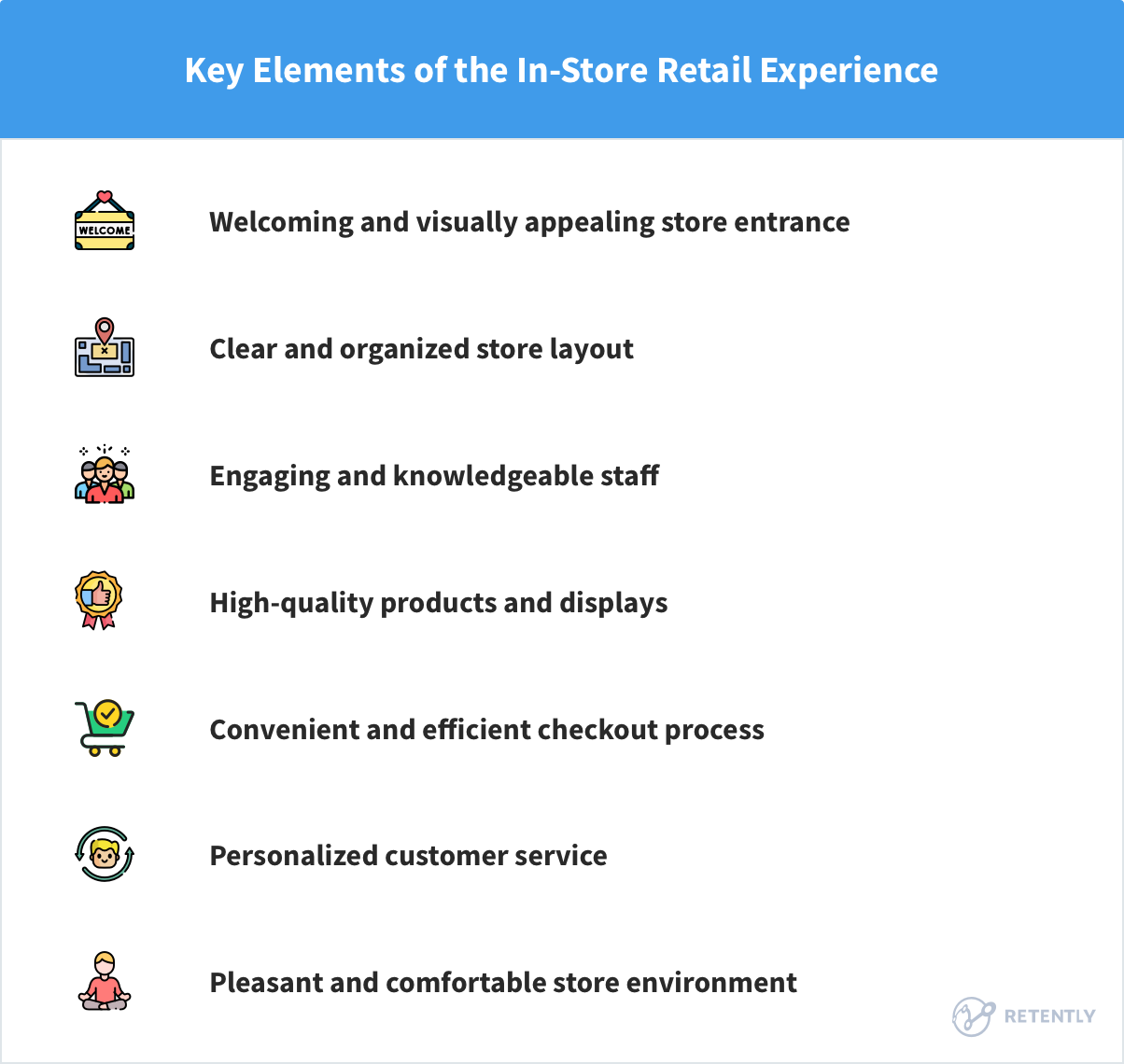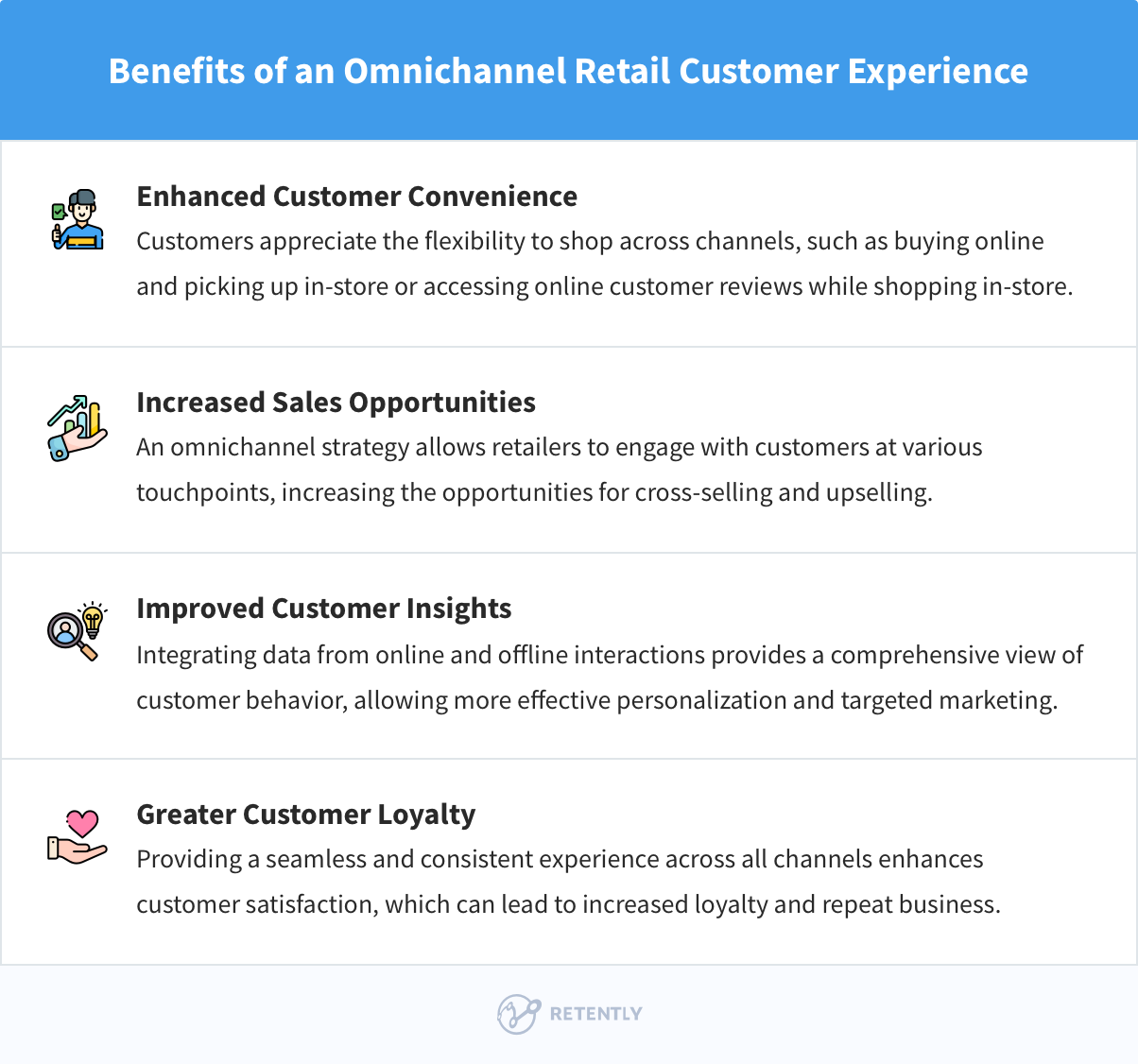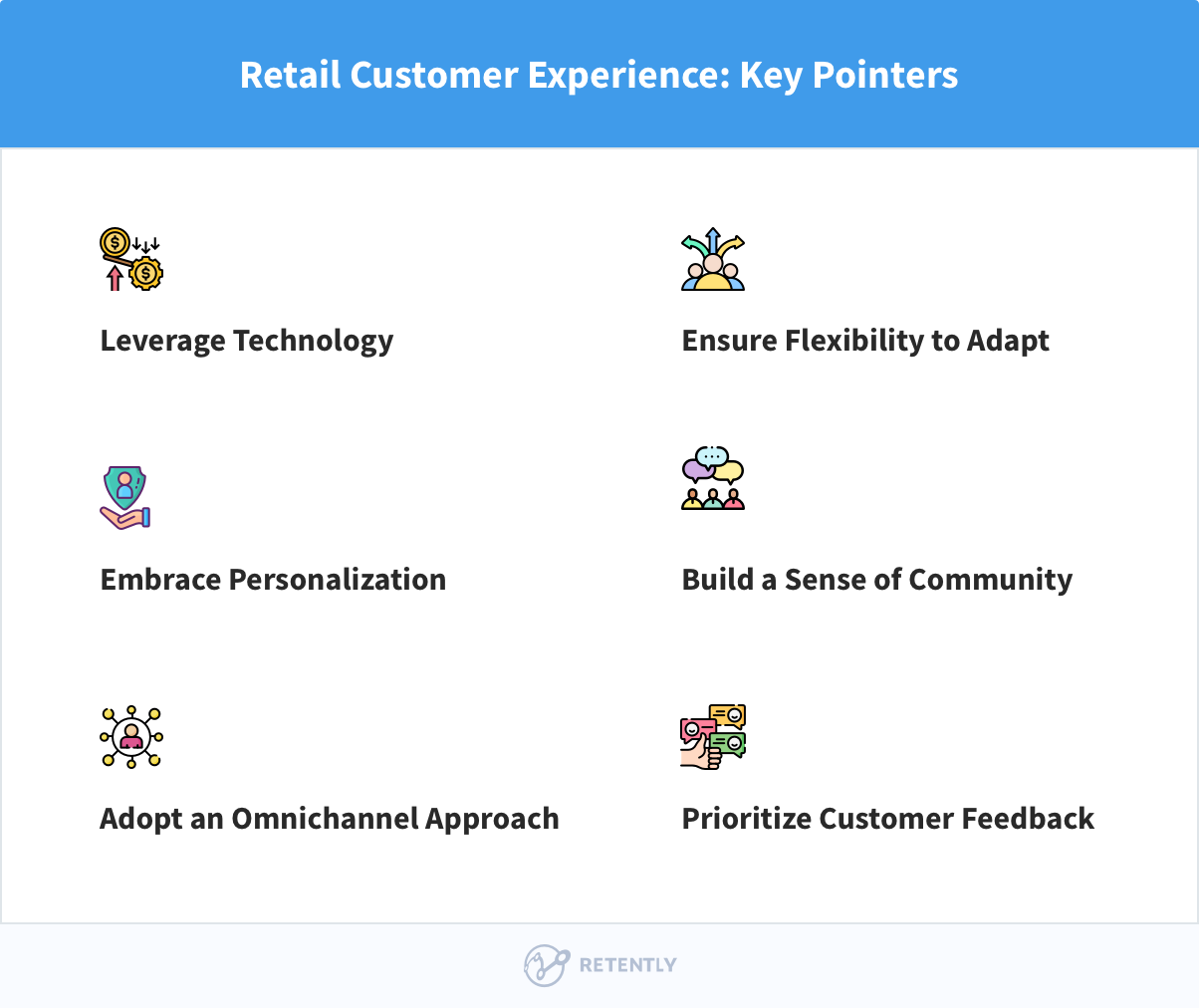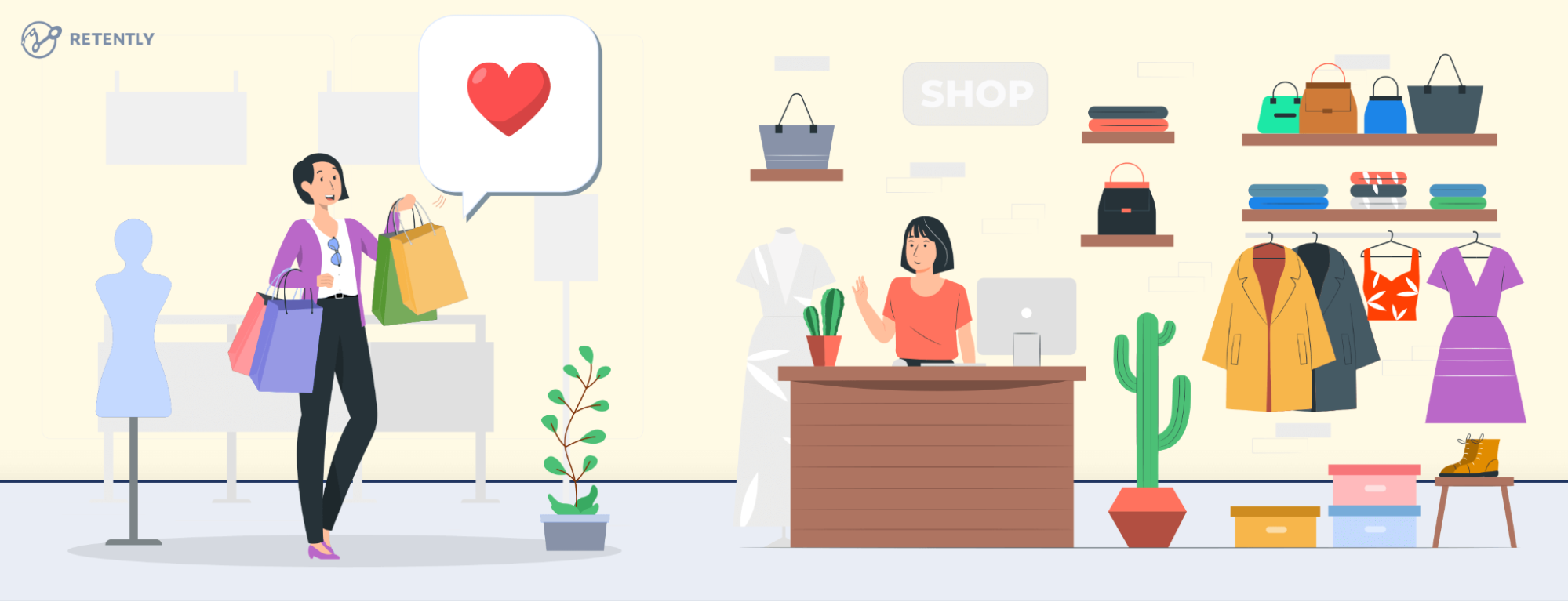What sets an exceptional retail customer experience apart? It’s an environment where shoppers feel understood and valued at every touchpoint.
Why does this matter so much? Because in a market brimming with choices, the way customers feel about your business can set you apart. A memorable retail customer experience leads to higher satisfaction, repeat business, and word-of-mouth recommendations.
Moreover, the lines between online and physical commerce are blurring. Today’s consumers might browse products online before purchasing in-store or use their smartphones to compare prices while shopping at a physical location. This interconnected retail context demands a cohesive approach, ensuring that customer experience is consistent and positive, regardless of how or where the customer chooses to shop.
Now, let’s cut to the chaise to uncover practical strategies that create such engaging retail experiences that foster loyalty and repeat business.
Key Takeaways
- A successful in-store customer experience strategy hinges on optimized store layout, interactive elements, demos, and personalized customer service, which all contribute to improved customer satisfaction and loyalty.
- Self-service options, including self-checkout systems and digital information kiosks, empower customers with autonomy and skill, improving the shopping experience and the retailer’s operational efficiency.
- Retailers leverage AI technology, such as chatbots and predictive analytics, to enhance customer experiences by providing immediate assistance and personalization.
- Both online and in-store experiences offer distinct advantages and can complement each other to provide a holistic and satisfying customer journey. Retailers who understand and strategically use an omnichannel approach are more likely to build strong, lasting relationships with their customers.
Understanding Retail Customer Experience
Customer experience in retail refers to the perception and sentiment of shoppers toward a brand throughout their journey – from the first point of contact to post-purchase interactions. It includes every touchpoint a customer has with the retailer, whether it’s walking into a store, speaking to customer representative or unwrapping the product at home.
Traditionally retail refers to the sale of goods and services through physical stores. However, with technological advancements, now most companies operate in both spaces: in-store and online. It’s the primary sales channel that will determine how these businesses are categorized.
Enhancing the In-Store Journey
A customer’s journey within a store is like a combo of senses and choices carefully designed to create a lasting impression of your brand. It’s a well-known fact that crafting a standout customer experience in retail is central to building customer loyalty and fine-tuning interactions for that magnetic draw.
Hence, in physical stores, the experience is tactile and sensory. A well-designed store environment not only reflects the brand’s identity but also makes shopping a pleasure, encouraging customers to linger, explore, and, of course, purchase.
Personal interaction takes a front seat, with knowledgeable and friendly staff capable of providing immediate assistance and enhancing customer satisfaction. In-store events and demonstrations can also create memorable experiences that can’t be replicated online. Essentially, the physical store isn’t just a place to buy products; it’s a venue where customers can engage with the brand in a meaningful way.
Therefore, the elements that make the in-store journey a standout experience include:
- a welcoming and visually appealing store entrance
- clear and organized store layout
- engaging and knowledgeable staff
- high-quality products and displays
- convenient and efficient checkout process
- personalized customer service
- pleasant and comfortable store environment (including lighting, music, scent, decor)

By investing in the physical retail space, brands create unique shopping experiences that draw customers in and encourage them to return. But let’s look into the most important elements to consider:
1. Store Layout Optimization
A strategic store layout is akin to a map, guiding customers through a journey of discovery and delight, where every turn reveals something new and engaging. A thoughtful merchandise placement can:
- increase foot traffic
- encourage customers to linger and explore
- maximize square footage
- optimize store flow
- create an environment that boosts revenue
- improve the customer shopping experience
Imagine aisles that invite rather than overwhelm and product arrangements that spark curiosity. The clever placement of popular items at the back of the store is not just a tactic; it’s a strategic game of engagement, nudging customers past other tempting products and potentially increasing impulse purchases.
Moreover, a store that is easy to navigate, with a layout that feels open and inviting, leaves customers with a sense of comfort and satisfaction that is likely to bring them back. Beware the trap of tight layouts and bottlenecks. They can quickly turn a shopping trip from a pleasure to a hassle, undermining the positive vibe you’re aiming for.
2. Interactive Elements and Demos
Physical stores are not just about transactions, but about creating memorable, immersive experiences. Innovative retailers are leveraging technology to enhance the in-store experience and boost brand awareness. The aim is to create an environment that motivates customers to return, not just for products but for the experience itself. It’s about stepping into a space where digital signage is more than just screens but what draws you into a deeper connection with a brand.
Through interactive features, retailers can engage customers in ways far beyond what static displays offer. Digital banners and interactive displays provide dynamic and engaging content, such as product information, product reviews, promotions, and tutorials, to aid in decision-making. These interactive displays serve as bridges between the online and offline, offering a buying experience that resonates with the tech-savvy shopper of today.
The use of VR or AR allows customers to visualize products in a real-world context or try things virtually, thereby enriching the shopping experience. Allowing customers to use their smartphones for in-store navigation, product lookup, or even to check out, creates a seamless experience that merges the benefits of online and offline shopping.
Some retailers use smart fitting rooms that can suggest complementary items, allowing customers to request different sizes or colors without leaving the fitting room, and even provide lighting adjustments to see the outfit in various environments. Smart shelves that monitor inventory in real-time, smart carts that guide shoppers through stores, and personalized discount offers sent directly to mobile devices – all contributes to a memorable retail customer experience.
In-store events are another way to enrich the brand perception, creating a sense of community and excitement. Workshops, product launches, and live demonstrations can draw customers into the store and create buzz around it.
The result? A customer experience that not only engages shoppers but also commits customers to their purchase, as they become active participants in their retail journey.
3. Personalized Customer Service
There is no substitute for excellent customer service. It’s the secret ingredient that turns casual shoppers into loyal advocates. When employees are happy, well-trained, and fairly compensated, they become the most effective ambassadors for your brand and deliver the customer care that shoppers expect, resulting in satisfied customers.
However, with the increasing demand for quick resolutions during service interactions, retailers often find themselves at a crossroads, struggling to meet customer expectations. The key lies in recognizing that each customer is unique, and their journey should be just as personalized. Whether it’s through tailored recommendations or a warm greeting that remembers a customer’s last purchase, personalization is not just about service – it’s about forging a relationship that keeps customers coming back for more.
Check our comprehensive guide for specific customer service tips to help you improve customer satisfaction.
Empowering Customers with Self-Service Options
When time is the new currency, empowering customers with self-service options is not just a simple convenience. The expansion of kiosks, online platforms, and mobile apps across sectors is proof of the value customers place on being able to independently complete tasks and access services anytime, anywhere – all without the dreaded wait in line. This autonomy improves the customer experience and enhances the retailer’s operational efficiency, allowing staff to shift their focus to other pressing tasks and potentially saving costs on staffing needs at checkout counters.
Furthermore, the use of self-service systems has been determined by health concerns, specifically during the COVID-19 pandemic, as a way to maintain social distancing and minimize contact. Let’s dive into how these self-service wonders are reshaping the retail experience.
Self-Checkout Systems
These systems save precious time and grant customers a sense of control and personalization that streamlines their overall shopping journey. The State of Self-Checkout Experiences report confirms this, revealing that about 42% of consumers prefer self-checkout for its undeniable speed and efficiency, and over half of the shoppers use self-checkout exclusively.
It’s a win-win situation; customers enjoy a streamlined shopping experience, and retailers benefit from increased transaction processing without a proportional rise in staffing – a blessing for operational efficiency. Moreover, employees who once manned registers can now be redeployed to other key in-store activities, such as restocking shelves and managing inventory, ensuring the store operates like a well-oiled machine.
Digital Information Kiosks
Digital information kiosks are the unsung heroes of the modern shopping experience, providing a treasure trove of information at the shopper’s fingertips. They enhance the in-store journey by:
- helping customers find products
- checking prices with ease, without the need to track down a busy store associate
- serving as on-demand information hubs
- empowering customers to make well-informed purchase decisions
- leaving them with a sense of satisfaction that comes from self-reliance
These digital assistants can even offer personalized recommendations, catering to individual preferences and tailoring the shopping experience to each customer. For those who want to navigate the store without a map, these kiosks act as self-help stations, equipped with interactive maps and multimedia content, all accessible without needing a staff member’s help.
Leveraging AI for Enhanced Retail Experiences
Retailers are harnessing the power of AI to speed up services and infuse a personalized touch that can secure customer loyalty for the long haul. This technology is set to transform customer experiences, with CEOs prioritizing customer service for their generative AI investments. This is rooted in the advanced capabilities of AI-powered tools with many acknowledging its potential to foster lasting loyalty via improved interactions.
Let’s explore how AI is stirring up interest across the retail industry.
AI-Powered Chatbots for Immediate Assistance
Chatbots powered by AI are the tireless customer service representatives of the digital age, providing instant responses and on-the-spot assistance. These virtual helpers are elevating customer service by being available around the clock, ready to address common queries, and guide shoppers through their purchasing journey.
The convenience and efficiency of chatbots are unmatched, offering real-time help and allowing customers to resolve their issues swiftly, without the need for human intervention. By simplifying product recommendations and aiding in the purchasing process, chatbots are improving customer service interactions, while transforming them into seamless, efficient exchanges that leave customers more likely to return.
Predictive Analytics for Personalization
Predictive analytics stands at the forefront of personalization, wielding historical data to foresee customer behavior and preferences. Retailers are tapping into this information, using statistical modeling and machine learning techniques to craft marketing campaigns and product recommendations that hit the mark. By predicting what customers want before they know it themselves, retailers can increase the likelihood of repeat purchases and deepen the customer-brand relationship.
The insights captured from customer data, be it from self-checkout kiosks or website analytics, are invaluable, enabling a shopping experience that feels as if it’s designed just for them, thanks to AI algorithms that understand purchasing behaviors and preferences.
Creating an Omnichannel Retail Experience
Today’s retail journey go beyond the traditional store boundaries, seamlessly blending the digital with the tangible experience of physical, brick-and-mortar shops.
Creating an omnichannel retail experience is about ensuring that customers can glide seamlessly from online to in-store to mobile app platforms without missing a beat. By integrating backend systems and employing omnichannel feedback strategies, retailers can build a consistent and coherent journey that delights customers and sets the stage for lasting loyalty.
An omnichannel approach, where online and offline strategies are fully integrated, offers several benefits:
- Customer Convenience: Customers appreciate the flexibility to shop across multiple channels, such as buying online and picking up in-store or accessing online customer reviews while shopping in-store.
- Sales Opportunities: An omnichannel strategy allows retailers to engage with customers at various touchpoints, increasing the opportunities for cross-selling and upselling.
- Customer Insights: Integrating data from both online and offline interactions provides a more comprehensive view of customer behavior, allowing more effective personalization and targeted marketing. For example, a customer’s online browsing and purchase history could inform in-store recommendations, or online wish lists could be accessible to sales staff to assist with in-store selections.
- Customer Loyalty: Providing a seamless and consistent experience across all channels improves customer satisfaction, which can lead to increased loyalty and repeat business.

However, to successfully implement this strategy, it is essential to address challenges like technological constraints and data fragmentation. Let’s explore how consistency and integrated support come together to create an effective omnichannel experience.
Consistency Across Channels
In the toolbox of retail channels, consistency is the thread that holds everything together. A consistent branding, messaging, values, even pricing across all platforms – be it your website, social media, email campaigns, or the physical in-store experience – help avoid customer confusion and reinforce a recognizable brand identity.
When every touchpoint sings the same tune, customers feel at ease, knowing that no matter how they interact with the brand, they can expect:
- the same quality of service
- the same experience
- the same level of professionalism
- the same attention to detail
Integrated Customer Support
The journey through an omnichannel set-up should be smooth, without any jarring interruptions. Integrated customer support ensures that a customer’s plea for help can start on one channel and seamlessly continue on another without the frustration of repeating themselves or starting afresh. When service staff can access the latest and complete view of customer interactions through system integration, they can deliver efficient assistance that feels personalized and considerate.
A consistent and high-quality service experience across all channels is a critical aspect of integrated customer support, as it builds confidence and reinforces the bond between customers and the retail brand. Whether a customer reaches out via social media, calls the customer service hotline, or asks for help in-store, the quality of service should be unwavering and responsive.
Real-life Examples: Engaging Customers Beyond the Screen
To make our exploration more complete let’s look into some examples showcasing outstanding retail customer experiences:
-
Nike’s flagship stores
Nike’s flagship store in New York City – House of Innovation 000 – spans 68,000 square feet and blends services like the Speed Shop, Instant Checkout, and Shop the Look. It offers a high-tech shopping experience where customers can use a mobile app to request shoes to try on, reserve items in a locker, and check out without standing in line. In-store technology improves the shopping experience, making it more convenient, personalized, and engaging.
Nike’s SoHo flagship store is not just about buying products, but an immersive experience where sports enthusiasts can engage with the brand in an interactive environment. It features a half-court for basketball, a soccer trial area, a treadmill that simulates outdoor runs, and a customization bar for personalizing sneakers. This space is designed to be more than just a store – it’s a venue where customers can test products in real sports scenarios, with advanced digital technologies that provide insights into their performance. Nike’s strategy integrates physical and digital retail, ensuring that even if customers leave without a purchase, their data enriches their future interactions with the brand, whether in-store, online, or through the app.
-
What about the design of Apple Stores?
Apple Stores stand out due to their distinct approach to customer interaction and store layout. They emphasize an open floor plan, eliminating traditional barriers like cash registers to create a more welcoming set-up. The stores’ staff, known for their expertise, are not on commission, fostering a more genuine customer relationship. Apple Stores also function as community hubs, fostering spaces where people can connect, learn, and engage with technology. The emphasis on experience over sales creates a customer-friendly environment that has become central to Apple’s retail success.
With offerings like coding workshops, creative sessions, and spaces for entrepreneurs, Apple is pushing the boundaries of what a store can be. This approach aligns with a broader retail trend where experience and community engagement are becoming as important as the products themselves. In 2022, Apple Stores generated over $70 billion in revenue, highlighting their success in the retail industry.
-
Lush’s sensory experience
Lush, once a niche brand, has grown significantly with under 1,000 stores worldwide, earning a reputation as a progressive and innovative brand in customer experience. Lush stores provide a sensory experience where customers can touch, smell, and try products. The store’s unique layout, resembling a deli or grocery store, encourages customer interaction with products through live demonstrations, creating an immersive and educational shopping environment. The ambiance is improved by shop-curated music, and some stores even offer coffee and vegan treats.
Lush’s commitment to eco-friendly practices is evident in its product packaging and store design, resonating with consumers’ growing environmental concerns. The brand is aligning its offline and online customer experiences, with technologies like Lush Lens and Lush Concierge to integrate digital tools with the physical store experience.
Collecting and Acting on Customer Feedback
Imagine walking into a store where everything feels tailored just for you – the products, the layout, even the background music. This isn’t just a happy coincidence; it’s the power of customer feedback in action. In retail, the voice of the customer is what guides the journey toward exceptional service. It provides invaluable insights into what customers love, what they dislike, and what they wish for.
By listening to what customers have to say and measuring their experiences against key performance indicators, retailers can develop effective strategies that align with customer expectations. Let’s explore the methods and impact of gathering customer feedback, a practice that informs and transforms how brands interact with their customers.
Methods for Gathering Feedback
How do you know if you’re truly aligned with customer expectations? It starts with understanding those expectations deeply and clearly. This might involve detailed market research, staying abreast of industry trends, and continuously engaging with customers to understand their evolving needs.
The quest for customer feedback can take many forms, including:
- Online Surveys, after purchase or at key interactions, for gauging customer satisfaction metrics like NPS, CSAT or CES.
- Focus groups which provide structured environments for gathering feedback and insights from a group of customers.
- On-site feedback forms and interviews, which allow customers to provide open-ended feedback and share their thoughts and experiences.
- Social media monitoring, which involves tracking and analyzing customer sentiments and feedback on platforms like Facebook, Twitter, and Instagram.
- Online reviews, which offer valuable insights into customer experiences and opinions.
Whether it’s through surveys, reviews, social media interactions, or direct communication, feedback is a valuable piece of the puzzle that can shape every aspect of the retail experience. It informs product selection, store design, staff training, and much more.
Implementing Changes Based on Insights
The true power of customer feedback lies in the actions taken in response. Analyzing feedback is an essential step for retailers to identify service areas that require improvement and to resolve issues proactively. By analyzing this data, retailers can identify patterns, anticipate needs, and avoid potential pitfalls, ensuring that every customer feels heard and valued.
Yet, meeting customer expectations isn’t simply about avoiding negative feedback but creating positive, memorable experiences that foster loyalty. It’s about being willing to adapt, whether that means introducing new products based on demand, redesigning store layouts for better flow, or implementing new technologies to streamline the shopping process. This alignment between what customers expect and what they receive is the sweet spot where satisfaction is born.
After implementing changes, monitoring their impact by keeping an eye on customer satisfaction is a must. This step is key to assessing how effective adjustments are and ensures you remain competitive.
A comprehensive CRM database can be instrumental in understanding customer needs, providing added value, and reducing brand switching. Additionally, the importance of loyalty programs cannot be overstated, playing a key role in boosting annual revenue by 12-18%. This highlights the importance of customer retention for business growth.
When a retailer gets this right, the benefits are clear: customers who feel understood and appreciated are more likely to return, to recommend the store to others, and to become advocates for the brand.
Driving Repeat Business with Loyalty Programs
Loyalty programs can turn a one-time buyer into a lifelong customer, creating a loop of repeat business that is the lifeblood of retail sustainability. They are carefully crafted to foster a positive relationship with customers, rewarding them for their ongoing loyalty to the brand. By offering a variety of incentives, these programs encourage customers to deepen their engagement.
Let’s explore how unique promotions and compelling loyalty programs are crucial in strengthening customer commitment and keeping sales flowing.
Exclusive Offers and Rewards
Exclusivity can tempt even the most cautious of shoppers. Exclusive deals and promotions extended to loyal customers make them feel valued and appreciated, thereby enhancing customer retention. It’s a gesture that says, “We see you, we value you, and we’re glad you’re here.” This feeling of being recognized for their loyalty encourages customers to make repeat purchases.
Points-based loyalty programs, reminiscent of Sephora’s Beauty Insider Program, transform each transaction into a chance to earn rewards, which can then be redeemed for products or experiences. The program features tiers with escalating rewards, encouraging more frequent purchases. The personalization of offers and recommendations based on purchase history improves customer engagement and loyalty.
Alternatively, value-based programs, like LEGO Insiders, reward customers for a variety of engagements, from purchases to community participation, thus promoting a broader interaction with the brand.
Other examples could include Amazon Prime, which provides members with benefits like free shipping, access to streaming services, and exclusive deals. The convenience and value offered by the program encourage customers to consolidate more of their shopping with Amazon, increasing repeat purchases and loyalty.
Starbucks uses a mobile app to facilitate its loyalty program, allowing customers to earn stars for purchases. The program offers free beverages, order customization, and mobile ordering, creating a seamless and engaging customer experience that encourages frequent visits. For more inspiration, check our guide on advocacy marketing strategies you don’t want to miss.
Regardless of the type – be it points, cash back, punch cards, tiers, or value-based rewards – these programs are designed to keep customers coming back for more.
Engaging Loyalty Program Structures
Loyalty programs that spark the customer’s imagination turn everyday shopping into an exciting journey. Offering experiential rewards and tailor-made challenges brings a thrilling twist to the usual shopping experience, making customers feel like they’re part of an engaging story.
There are different types of loyalty programs that brands can implement, including:
- Tiered loyalty programs, which entice customers to climb the ranks and unlock increasingly better rewards as they spend or engage more with the brand
- Subscription-based models, which offer an ongoing stream of benefits for a fee
- Loyalty programs that incorporate gamification elements, which inject a playful and competitive spirit into the shopping experience, driving repeated interactions and boosting revenue.
Such engaging loyalty program structures not only reward purchases, but create a journey that customers are eager to continue.
Quick Wins
Today’s consumers, especially younger generations, have high expectations for retail experiences. They value convenience, speed, personalization, and sustainability. They expect seamless integration between online and offline channels and prefer brands that align with their social and environmental values. In order to remain relevant, retailers need to stay attuned to these evolving expectations and adapt their CX strategies.
Here are a few pointers to look into if you want to stand the test of time:

- Stay abreast of the latest technology and integrate relevant innovations to improve efficiency and create more engaging customer experiences. Whether it’s adopting AI for personalized recommendations, using AR for virtual try-ons, or implementing IoT for improved in-store interactions, the right technologies can significantly elevate the customer journey.
- Leverage data to understand and anticipate customer needs. Embrace personalization and strive to offer tailored experiences, products, and services to meet individual customer preferences. This can range from personalized product recommendations online to personalized services in-store, all designed to make the customer feel understood and valued.
- Retail is rapidly evolving, so as a retailer you need to adapt to changes in consumer behavior, market trends, and technology. This could mean introducing new products or customizing services while delivering an integrated, omnichannel customer experience. For example, if feedback indicates a growing demand for eco-friendly products, a retailer might respond by expanding their range of sustainable offerings.
- Create a sense of community around your brand can foster loyalty and repeat business. You can achieve this through engaging in-store events, active social media presence, and community involvement.
- Prioritize customer feedback. Establish strong mechanisms for collecting and analyzing customer feedback across all touchpoints. Actively listen to your customers and involve them in shaping their shopping experience. Feedback should not only be monitored but also acted upon. It proves that customer opinions are valued and instrumental in driving business improvements.
Conclusion
The ultimate goal of any retail strategy is to meet and exceed customer expectations, turning satisfied shoppers into loyal advocates for the brand. But how can retailers ensure their strategies are in tune with what customers want?
First and foremost, it’s about listening to what customers are saying. This means not only collecting feedback but also analyzing it and translating it into actionable insights. It’s about spotting trends, understanding preferences, and anticipating needs before they become demands.
Start by taking a deep dive into what you’re currently doing – spot what’s working well, pinpoint where you can do better, and get a grip on the changing wants and needs of your buyers. Set specific goals to boost the customer experience, whether that means sprucing up your store’s environment, giving your online presence a facelift, or bringing in new technology to make the whole shopping journey smoother and more captivating.
By staying committed to understanding and improving the retail customer experience, you can look forward to thriving in the dynamic retail set-up. Leverage the voice of the customer with Retently, automate feedback collection and analysis in no time, and drive informed decisions. Start a free trial and learn how to better serve customer needs.





























 Greg Raileanu
Greg Raileanu 

 Alex Bitca
Alex Bitca 
 Christina Sol
Christina Sol 

